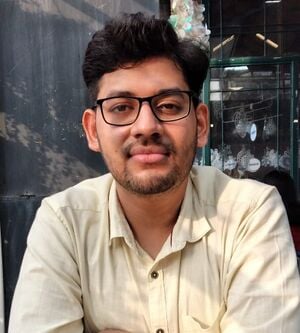About myself[edit | edit source]

Hello, my name is Sagnik and I am currently a Graduate Student in the MEEM (Mechanical Engineering – Engineering Mechanics) department at Michigan Technological University, looking to specialize in Renewable Energy. I hail from Kolkata, India, and that was where I have done my Bachelors (undergraduate) studies. My minor was also Mechanical Engineering and my capstone project involved construction of a small-scale, domestic, decentralized biogas reactor.
After my Undergrad, I worked for a brief while as a Marketing dept. GET (Graduate Engineer Trainee) at Paharpur Cooling Towers Ltd, the biggest cooling tower manufacturing firm in India.
I have also worked for Make-a-Wish India.
Research Experience and Publications[edit | edit source]
- For my capstone project in Undergrad, I led a four-member team that successfully constructed the prototype of a small-scale, domestic, decentralized biogas reactor. The goal of the project was to explore the possibilities of using biogas for cooking purposes as an alternative to liquefied petroleum gas (LPG) for a small apartment building of 10-15 families with an assumed four members per family. In the designed model of the biogas reactor, we utilized anaerobic fermentation or Anaerobic digestion process to design a small-sized, decentralized, portable, Fixed dome digester for application in the urban environment. In order to reduce the number of moving parts, we proposed that each of the three containers for the three stages of the anaerobic fermentation process be placed at different heights and thereby utilize gravity to transfer the substrates through the different stages. The experimental data revealed that 150 ml of biogas were generated from 2 kg of solid waste. We thereafter appropriated the research findings into a paper titled “Design of a Decentralised Biogas Reactor” which has been published by Springer Nature as a book chapter, as part of a book titled “Energy Recovery Processes from Wastes.”
- I also worked on a project titled “Stenocara Water Harvester”, which was among 20 shortlisted student projects all across India to receive the prestigious ISHRAE Student Project Grant (ISPG) 2016-17. This project aimed at mimicking the fog-harvesting capability of the Stenocara beetle, found in the Namibian desert, which generates its own drinkable water from the scanty atmospheric moisture present in the air of the arid desert climate. Utilising the concept of reduction of soil temperature with depth, and the constancy of ground temperature at a certain depth, my team and I successfully developed a prototype for a water harvester which generated usable water from atmospheric moisture. The main challenge faced was to artificially develop hydrophobic bumps on a hydrophilic surface in order to recreate the surface profile of the wings of the beetle, which helps in condensing the water on the hydrophobic bumps and storing it on the hydrophilic surface. It was observed that the apparatus was able to harvest 1.02 litres of water from atmospheric moisture during a 24-hour period, without the use of electricity. The result would obviously depend on the air temperature, humidity, wind conditions, soil nature, ground temperature, altitude, etc. of the location where the apparatus is installed. We conducted the experiment on the outskirts of Kolkata, India, in the month of March. Recreating the same experiment at another time in another geographical location would theoretically yield different results, which we could not carry out due to lack of necessary funds.
- I also co-authored a paper titled “A Review on the Advancements in 3D Printing and Additive Manufacturing Technologies” which I presented at the 1st International Symposium on 3D Printing Technologies, 2018, and had it published in the proceeding book of the same (ISBN: 978-93-5311-294-3).
Ongoing projects[edit | edit source]
- Thermo-Economic Viability Analysis of a Photovoltaic Heat Pump System for Space Heating Purposes in Cold Climates of Northern USA: A study aimed to look into the potential savings by operating a heat pump on solar energy instead of natural gas, and looking for potential ways in which the users might get subsidized by the government or by the power supply authority thus resulting in a non-zero sum game where the consumer, the power supply authority and the environment, everyone is benefitted